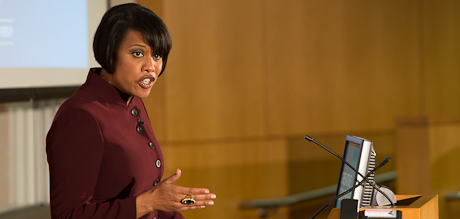Baltimore Mayor Stephanie Rawlings-Blake had a message for George Washington University School of Business students, faculty and staff during a speech Monday. For those whose only knowledge of Baltimore comes from the television series “The Wire,” which depicts crime and corruption in Baltimore, things have changed.
During the ’90s, more than 300 people were killed each year, but since 1997, both violent crime and property crime has dropped by 50 percent. In 1997, only 46 percent of students graduated from high school. Last year, 72 percent received their diplomas. And neighborhoods are thriving where barren lots and abandoned warehouses used to sit.
“As skillfully crafted as that show was, it really in my mind only showed one side of the city
And the show reflects more of how Baltimore used to be in the ’90s than how it is today,” said Ms. Rawlings-Blake. “So much has changed.”
Ms. Rawlings-Blake was the second speaker in the School of Business’s Conversations on Creative Leadership series. The first speaker, Marin Alsop, conductor and music director of the Baltimore Symphony Orchestra, addressed the GW community on Nov. 19. The school’s Creative Leadership in Civic Life Initiative aims to create great leaders who can leverage their business skills to foster and sustain strong communities.
Last month, the District released its Economic Development Strategy for the District of Columbia – a five-year plan that seven GWSB M.B.A. students helped author. The six-part plan is expected to create 100,000 new jobs and generate $1 billion in new revenue for the District.
“In addition to being the place where young civic leaders are trained with business skills, I want to be the place that first and foremost is thinking about women and leadership,” said GWSB Dean Doug Guthrie.
Ms. Rawlings-Blake, now 42, was first elected to the Baltimore City Council in 1995 – the youngest person ever elected. In January 2007, she was elected council president, and in 2010 she became mayor of Baltimore. From the beginning of her term, she has set an ambitious goal for her hometown: grow Baltimore’s population by 10,000 families over the next decade by improving public safety and public education and by strengthening city neighborhoods.
“We believe public education is a cornerstone for growing cities,” said Ms. Rawlings-Blake. “We’re no longer allowing our kids to simply slip through the cracks of low expectations. That’s over. We’re demanding achievement.”
The city is beginning to see changes. This school year marked the fifth consecutive year of increased enrollment in Baltimore’s public schools, and the city now is home to 33 charter schools – more than any other school district in Maryland. Property taxes are lower. Under Armour is about to break ground on a large office complex. Micro-loan financing is helping small businesses open in the city. Partnerships are being strengthened with the city’s major job creators. And a new waterfront neighborhood called Harbor East, which boasts shops, restaurants, hotels and condos, is attracting new residents.
“Cities can do incredible things, but they really need creative leadership these days to achieve it,” said D.C. Deputy Mayor Victor Hoskins during his opening remarks. “Mayors probably have the hardest job in the country. To run a city, you not only have to understand policy, you have to understand how policy turns into opportunity. You not only have to understand finance, you have to understand how finance in an age of limited resources can be used to create more than you started with.”
Ms. Rawlings-Blake said when it comes to being a strong civic leader, knowing how to compromise and build coalitions are vital skills.
“If you can’t see the benefit to working cooperatively and building consensus, it will be difficult for you to be a leader or at least be a good leader for long,” she said.
While Ms. Rawlings-Blake is proud of her city’s transformation, she said it’s not a cause for celebration but rather a cause for further action from city residents, the business community and the nonprofits to say “we can do more.”
“Crime and taxes are still too high. Schools must improve more. There are far too many vacant homes and not enough new jobs. Baltimore lost nearly 40 percent of its population since 1950. That means we have more work to do to get Baltimore growing again,” she said. “We’re in it for the long run.”


